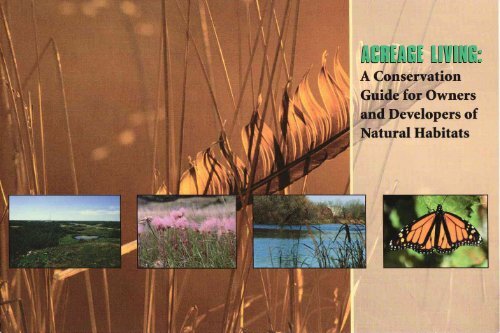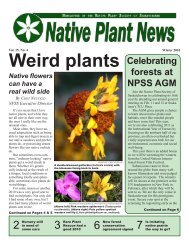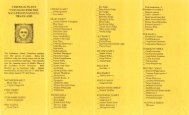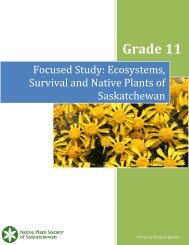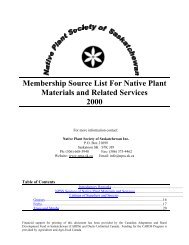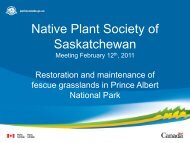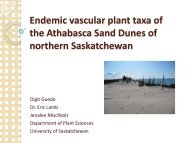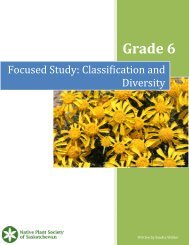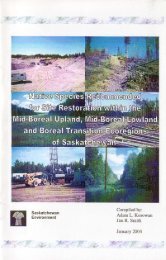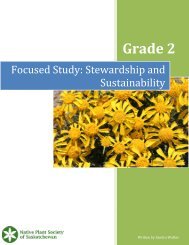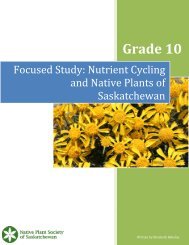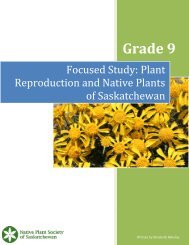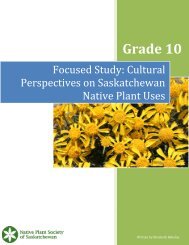Acreage Living - Native Plant Society of Saskatchewan
Acreage Living - Native Plant Society of Saskatchewan
Acreage Living - Native Plant Society of Saskatchewan
You also want an ePaper? Increase the reach of your titles
YUMPU automatically turns print PDFs into web optimized ePapers that Google loves.
al Habitats
Your Home Place,Your Landscape,Your Legary... .......... 1<br />
lntroducing <strong>Native</strong> Prairie ........2<br />
\A4rat is <strong>Native</strong> Prairie? .........2<br />
A Threatened Resource ...... .4<br />
WhyShouldWeCare? ..........6<br />
Planning and Development . ...... ..7<br />
<strong>Acreage</strong> Subdivision Planning for Municipalities and Developers .. .. .. .7<br />
PlanningYour<strong>Acreage</strong> -Your Home Place - Your Legacy .......7<br />
BuildingYour<strong>Acreage</strong> ..........9<br />
Management . .. .. ..... . 10<br />
Vegetation Management ..... . 10<br />
Weed Management . .. .. . l0<br />
Woodlands ....... 11<br />
Fire Hazard and Litter Control<br />
Livestock Grazing and <strong>Native</strong> Prairie<br />
<strong>Acreage</strong>s and Wild Animals .<br />
Water on your Land<br />
Enjoying your <strong>Acreage</strong><br />
A Healthy Rural Landscape - Now and for The Future<br />
Resources<br />
Selected Publications<br />
General Interest<br />
Field Guides .....20<br />
Restoration,LandscapingandManagement ... ............20<br />
Contacts ........ ...21<br />
12<br />
13<br />
16<br />
17<br />
18<br />
t9<br />
20<br />
20<br />
20
Published by:<br />
<strong>Native</strong> <strong>Plant</strong> <strong>Society</strong> <strong>of</strong> <strong>Saskatchewan</strong> Inc., 2001<br />
Principal Writers and Contributors:<br />
Andy Hammermeister, <strong>Native</strong> <strong>Plant</strong> S.ociety <strong>of</strong> <strong>Saskatchewan</strong> Inc.<br />
Terry Klassen, Browning Design Inc.<br />
Lesley Hall, <strong>Saskatchewan</strong> Wetland Conservation Corporation<br />
Chris Nykoluk, Prairie Farm Rehabilitation Administration<br />
Llnn Oliphant, Prairie Institute for Human Ecology<br />
Karyn Scalise, Prairie Conservation Action Plan<br />
Edited by:<br />
Sara Williams, University <strong>of</strong> <strong>Saskatchewan</strong> Extension Services<br />
Shelley Ross<br />
Funding and other support provided by:<br />
Habitat Stewardship Program, Environment Canada<br />
<strong>Saskatchewan</strong> Prairie Conservation Action Plan<br />
<strong>Saskatchewan</strong> Environment and Resource Management<br />
Ducks Unlimited Canada<br />
<strong>Native</strong> <strong>Plant</strong> <strong>Society</strong> <strong>of</strong> <strong>Saskatchewan</strong> Inc.<br />
Browning Design Inc.<br />
<strong>Saskatchewan</strong> Wetland Conservation Corporation<br />
Prairie Farm Rehabilitation Administration<br />
Land Stewardship Centre <strong>of</strong> Canada<br />
Canadian Adaptation and Rural Development Program in <strong>Saskatchewan</strong>,<br />
Agriculture and Agri-Food Canada<br />
tppit Resources Ltd.<br />
The contribution and support <strong>of</strong> the following<br />
individuals and agencies are gratefully acknowledged:<br />
Other Contributors:<br />
Robyn Choropita, KLA Group Inc.<br />
Laura Nanninga, Browning Design Inc<br />
Renny Grilz, Ducks Unlimited Canada<br />
Dean Nernberg, Canadian Wildlife Service, Environment Canada<br />
Anna Leighton<br />
<strong>Acreage</strong> owner review by:<br />
Doug and Anne Hildebrand<br />
Norinne Keys<br />
Brant Remenda<br />
|udith and Bill Fox<br />
Layout and Printing by:<br />
Houghton Boston Printers and Lithographers<br />
Photo Contributors:<br />
Keith Barr<br />
Don Galton<br />
Joe Lltle<br />
Todd Andrews<br />
Phil Taylor<br />
Lorne Klein<br />
Heather Dundee<br />
Gary Bowes<br />
Patrick Porter<br />
Shelley Ross<br />
Nora Stewart<br />
Andy Hammermeister<br />
Donald Fontaine, <strong>Saskatchewan</strong> Agriculture and Food<br />
Dean Nernberg, Canadian Wildlife Service, Environment Canada<br />
Angela Salzl, <strong>Saskatchewan</strong> Purple Loosestrife Eradication Project<br />
Adrian Sturch, Grasslands National Park<br />
Bruce Hesselink, Agriculture and Agri-Food Canada (AAFC),<br />
Prairie Farm Rehabilitation Administration (PFRA)<br />
Alberta Agriculture, Food and Rural Development<br />
Ecosystem Image Information System, <strong>Saskatchewan</strong> Conservation Data Centre<br />
<strong>Saskatchewan</strong> Wetland Conservation Corporation (SWCC)
Missouri Coteau<br />
ll creage living abounds with<br />
llexperiences connecting you to<br />
the land... fresh air, wildlife<br />
viewing, a sense <strong>of</strong> freedom and<br />
privacy, rural community,<br />
colourful sunsets, peaceful<br />
surroundings, raising animals and<br />
growing crops. <strong>Acreage</strong> living can<br />
be a very rewarding and<br />
wholesome experience.<br />
As an acreage owner, your<br />
interests, needs and values that<br />
bring you to the country may<br />
differ from those <strong>of</strong> your<br />
neighbours. These interests<br />
ultimately determine how your<br />
acreage is developed and<br />
managed. In moving to the<br />
country, you become a part <strong>of</strong> a<br />
rural community that has<br />
developed over decades and<br />
generations. Disturbance to the<br />
environment and adjustments in<br />
Iifestyle are unavoidable.<br />
Working as a community,<br />
respecting the needs and<br />
livelihoods <strong>of</strong> others and caring<br />
for the environment, however,<br />
are in everyone's best interest.<br />
<strong>Living</strong> on an acreage, we have<br />
a large impact on the wild plants<br />
and animals that make country<br />
living so enjoyable. All <strong>of</strong> us<br />
depend on a healthy and diverse<br />
landscape with clean water and<br />
fresh air. When we move to the<br />
country we must learn to<br />
minimize our impact and respect<br />
the beautiful and d1'namic life that<br />
is already present. A balance<br />
between the activities and lifestyle<br />
we enjoy with a respect for the<br />
natural environment is achievable.<br />
This booklet is intended to<br />
guide acreage owners and<br />
developers to conservation<br />
minded practices when<br />
developing and managing<br />
acreages. lt outlines ways in<br />
which visions <strong>of</strong> country living<br />
can be fulfilled while maintainine<br />
the surrounding natural<br />
environment. It <strong>of</strong>fers practical<br />
tips for minimizing impact on<br />
the land, from development to<br />
management and enjoyment. It<br />
also includes a list <strong>of</strong> resources<br />
for further information.
he <strong>Saskatchewan</strong><br />
f prairies had<br />
I their beginnings I6,000 years<br />
ago as the glacial ice melted. The<br />
soil types and landforms left in<br />
the wake <strong>of</strong> the glaciers, along<br />
with a harsh climate and<br />
disturbances resulting from<br />
periodic fires and grazing<br />
animals, created a unique<br />
environment. Over thousands <strong>of</strong><br />
years, the prairie landscape<br />
evolved to include a wide variety<br />
<strong>of</strong> plant and animal species<br />
particularly suited to and<br />
dependent upon, these<br />
environmental conditions. The<br />
open grassland interspersed with<br />
lakes, ponds, creeks, river valleys,<br />
shrubs and trees supported<br />
aboriginal peoples, huge herds <strong>of</strong><br />
grazinganimals and a myriad <strong>of</strong><br />
birds, insects and other wildlife.<br />
These age-old plant communities<br />
<strong>of</strong> the prairie and parkland<br />
regions <strong>of</strong> <strong>Saskatchewan</strong> are what<br />
we refer to as native prairie.<br />
Grasses dominate native<br />
prairie, but it is incredibly diverse!<br />
A close look at the prairie<br />
uncovers hundreds <strong>of</strong> different<br />
species <strong>of</strong> grasses and wildflowers.<br />
In addition to open grassland, we<br />
see wetlands, saline patches,<br />
shrubs and even forested tracts.<br />
These com mun ities contain<br />
different groups <strong>of</strong> plants, each<br />
providing a different habitat for<br />
wildlife. From early spring to late<br />
fall, the display <strong>of</strong> flowers, colours<br />
and textures in the prairie<br />
constantly changes and delights.<br />
Does your land contain native<br />
prairie? Old furrow lines or rock<br />
piles likely mean the area<br />
was cultivated in the past,<br />
but some cultivated fields<br />
may have reverted to native<br />
species if they were not<br />
cropped for long. <strong>Native</strong><br />
prairie vegetation contains<br />
many different kinds <strong>of</strong><br />
plants and you will notice a<br />
changing variety <strong>of</strong> flowers<br />
throughout the growing<br />
season. <strong>Plant</strong>s such as Needle and<br />
Thread Grass, Prairie Crocus and<br />
Western Snowberry ( Buckbrush)<br />
are good indicators <strong>of</strong> native<br />
prairie. For help with<br />
identification, use plant<br />
identification guides or consult<br />
with a local expert.<br />
Did you know that<br />
on a 4-hectare (]O-acre)<br />
parcel <strong>of</strong> native prairig<br />
you may find as many as<br />
200 different types <strong>of</strong><br />
grasset flowers and<br />
shrubs!
Purple Prairie Clover<br />
Dean Nernberg<br />
Upland Sedge<br />
A Hamnerneister<br />
Blue Grama Grass<br />
SWCC<br />
Western Red Lily<br />
Keith Batr<br />
Needle and Thread Grass<br />
Dean Nernbera<br />
Ascending Purple Milk Vetch<br />
Dean Nernbery<br />
Snowberry<br />
AAFC PFRA<br />
Rockpiles are indicalors 0f cultivati0n<br />
Don Gayton<br />
Prairie Crocus<br />
A Hammerneister<br />
Harebel I<br />
Danald Fontaine SAF
n the last 150<br />
I years, most <strong>of</strong> the<br />
I na tivc pra iric in North A merica<br />
has disappeared. In <strong>Saskatchewan</strong>,<br />
it is estimated that close to 80% <strong>of</strong><br />
the prairie has vanished, while in<br />
areas <strong>of</strong> prime cropland, less than<br />
two percent <strong>of</strong> the original prairie<br />
remains. \\4rlt little prairie<br />
remains exists under quite<br />
different conditions than it has for<br />
thousands <strong>of</strong> years. The most<br />
obvious changes are the<br />
fragrnentation <strong>of</strong> native habitat<br />
caused by road building, resource<br />
extraction, residential<br />
development and encroaching<br />
cultivation. Less obvious changes<br />
that threaten the prairie are the<br />
disappearance <strong>of</strong> prairie fires and<br />
the once massive herds <strong>of</strong> bison,<br />
the arrival <strong>of</strong> rrew and aggressive<br />
introduced (i.e., exotic) plants<br />
that displace native species and<br />
long-term overgrazing or a total<br />
lack <strong>of</strong> grazing. Examples <strong>of</strong><br />
exotic plants include Smooth<br />
Brome, I(entucky Bluegrass, and<br />
Quack Grass. Even native shrubs<br />
and trees may pose a threat to the<br />
grassland when they expand<br />
beyond their historical extent.<br />
Invasion ol exolic Smoolh<br />
Brome grass on prairie<br />
Dean Nenberc<br />
:r{<br />
r:<br />
Breaking prairie
Ma0 <strong>of</strong><br />
rEmarnrng<br />
native prairie<br />
lredl<br />
in Southern<br />
$askatchewan"<br />
lnage courtesy <strong>of</strong> Canadian Wikllife Service, Environnent Canada
I<br />
,,<br />
,,,,_ :<br />
he disappearance<br />
f<br />
oI native<br />
I prairie means the<br />
disappearance <strong>of</strong> thousands <strong>of</strong><br />
years <strong>of</strong> evolutionary history. This<br />
resource can never be replaced.<br />
The prairie vegetation is vital to<br />
the survival <strong>of</strong> countless wildlife<br />
species, many <strong>of</strong> which have<br />
already dropped significantly in<br />
number. \A4rile species such as the<br />
Swift Fox, Sage Grouse and<br />
Burrowing Owl are endangered,<br />
other species such as the Plains<br />
Grizzly Bear and Greater Prairie<br />
Chicken have already been lost.<br />
Conserving native prairie not<br />
,<br />
only conserves plant and animal<br />
species, it also provides direct<br />
benefits to the human inhabitants<br />
<strong>of</strong> the prairies. These benefits<br />
include good quality water,<br />
aesthetic and recreational<br />
opportunities, soil protection and<br />
a gene pool available for future<br />
medical and agricultural<br />
utilization. Humans play an<br />
important role in the prairie<br />
landscape. Careful planning and<br />
management can help us<br />
continue to live in and make use<br />
<strong>of</strong> the prairies in a positive way,<br />
without degrading the habitat<br />
values for other species.<br />
Endangered<br />
Burrowing<br />
Owl
<strong>Acreage</strong> S division<br />
Planning for nicipalities<br />
and D lopers<br />
flreating<br />
and protecting<br />
developers <strong>of</strong><br />
For rural country<br />
municipalities, residential<br />
developers and subdivisions.<br />
Rural<br />
homeowners<br />
municipalities<br />
there is an<br />
should<br />
importance <strong>of</strong><br />
encourage the<br />
green or<br />
development<br />
natural areas <strong>of</strong> residential<br />
to our quality settings that<br />
<strong>of</strong> life...<br />
mlnlmze<br />
disturbance to<br />
rural<br />
compact development pattern cultivates harmony<br />
could be dedicated to preservation<br />
<strong>of</strong> the natural region, wildLife<br />
corridors and recreational trails. As<br />
with the natural<br />
landscape. Carefi,rl<br />
planning <strong>of</strong> these<br />
Ucommuniry values is a chalJenge<br />
a developer <strong>of</strong> country residential<br />
subdivisions, begin your next<br />
developments can<br />
significantly reduce<br />
for both rural municipalities and project by identifying potential damage to the<br />
areas worth protecting. Locate natural landscape,<br />
homes, infiastructure and roads at avoiding the need<br />
a respectful distance from these for costly repair at<br />
protected areas. A compact design<br />
can actually be more cost effective<br />
for the developer.<br />
CurrenLly, typical zoning<br />
bylaws tend to mandate sprawl by<br />
requiring large individual acreage<br />
parcels. While large lots seldom<br />
promote a strong sense <strong>of</strong> rural<br />
community, smaller lots with large,<br />
natural common areas <strong>of</strong>fer many<br />
opportunities to interact with<br />
a later date.<br />
PlanningYour<br />
reage - Your<br />
Home Place -<br />
Your Legacy<br />
Jvery<br />
neighbours. The traditional<br />
approach has generally been to<br />
clear natural bluffs <strong>of</strong> trees, to<br />
flatten land and to create large,<br />
high maintenance lawns and<br />
gardens. To preserve the natural<br />
landscape, we should be<br />
promoting smaller lawn areas that<br />
minimize disturbance <strong>of</strong> the<br />
prairie. Smaller lawns and<br />
traditional garden areas should be<br />
combined with an approach that<br />
landowner<br />
the natural qualities <strong>of</strong> the land<br />
lshould develop a<br />
plan that<br />
mtegrates<br />
and encourage conseration <strong>of</strong><br />
personal goals<br />
native habitat. Development<br />
with the natural<br />
policies and guidelines should<br />
resources on their<br />
provide for common areas for<br />
land. Walk around<br />
walking, horseback riding or other<br />
your acreage and<br />
community-based recreation. Rural<br />
map out features<br />
municipalities should encourage<br />
such as wetlands<br />
designs where rural lanes flow with<br />
and streams,<br />
the natural topography and groups<br />
natural water<br />
<strong>of</strong> homes clustered around a grassy<br />
drainage patterns,<br />
common area complete with a<br />
bluffs, grassy<br />
wetland. Land saved by this areas, lnvaslve<br />
Plan couftesy <strong>of</strong> Bnwning Design In.
weed problems and wildlife trails.<br />
Note existing human-made<br />
features such as roads, power and<br />
gas lines, gardens, buildings,<br />
wells, and septic fields. If you are<br />
starting construction on a new<br />
property, take the existing site<br />
characteristics into account as<br />
you position the house, other<br />
buildings, roads and utilities.<br />
Consider the impact <strong>of</strong><br />
construction on the natural<br />
Iandscape. You may not eliminate<br />
damage, but you can take<br />
measures to minimize il.<br />
The next step in the design<br />
process can be a lot <strong>of</strong> fun. On<br />
your diagram, identifii potential<br />
uses for different parts <strong>of</strong> your<br />
acreage, as always, minimizing<br />
disturbance. Locate your house<br />
where it will be naturally<br />
sheltered. Ifyou need a<br />
windbreak, try using multiple<br />
rows <strong>of</strong> native trees and shrubs in<br />
a meandering pattern with<br />
shorter plants on the outside.<br />
Make every effort not to displace<br />
existing native vegetation.<br />
Remember the house and<br />
immediately surrounding area<br />
does not need to be expansive but<br />
rather scaled to suit your lifestyle.<br />
Sketch in specific use areas such<br />
as a vegetable garden, dog run,<br />
pathways, viewing benches,<br />
play areas, pastures and corrals.<br />
Thke into account how you are<br />
currently using the yard. Include<br />
existing topographical features<br />
such as slopes, hills, well- or<br />
poorly drained areas, eristing<br />
wildlife habitat in your yard<br />
and adjacent areas, soil types,<br />
shade and sun and<br />
the direction <strong>of</strong><br />
prevailing winds. Also<br />
remember that there<br />
is no compelling need<br />
to landscape from<br />
property line to<br />
property line. There<br />
is more to living in<br />
the country than<br />
ridi4g a lawn mowerl<br />
It's your choice.<br />
A Uisitn lor Gountry liuing<br />
Whether you are a municipal policymaker, developer or acreage<br />
owner, your vision <strong>of</strong> country living will have a tremendous<br />
influence on how your acreage or acreage subdivision is designed<br />
and managed. Discussing your vision and goals with other<br />
landowners in the neighbourhood can be informative, generate<br />
new ideas and avoid problems ln the long run. The vision <strong>of</strong> any<br />
one developer or owner may differ from that <strong>of</strong> others. Some<br />
goals will have less impact on the environment and community<br />
than others. In most cases compromises can be reached. Try and<br />
find a compromise for each pair <strong>of</strong> points in the lists below<br />
Gonseruatiun is lliiler Priority[onsenualion<br />
is lnlrtter Priority<br />
. Low maintenancq low input . Well groomed, irrigated,'weed' free<br />
. Quality <strong>of</strong> lifg healthy living<br />
. A place to retreat self-educate<br />
" Financial investment<br />
. Source <strong>of</strong> income<br />
. Wildflowers, native plants<br />
. Wildlife<br />
" Flower garden/landscaping<br />
. Roaming dogs<br />
. Well-managed grazing . Overgrazing by horses and cattle etc.<br />
. Natural space<br />
. Storage/work space<br />
. Hiking skiing biking . All terrain vehicles, motor bikes<br />
Low impact walking trail 0n prairie Gardens can be a part 0f acreage living
Utifity line disturbance - A Hanmerneister<br />
ColleGting nalive seed - reim aar<br />
Seeding nalive planls - snrcc<br />
BuildingYour reage<br />
llcreage development impacts can<br />
llbe minimized with carefill<br />
planning and an awareness <strong>of</strong><br />
where problems may arise. Tiy to<br />
minimize the area that will be<br />
disturbed by keeping building areas<br />
small. Avoid wetland areas or other<br />
areas <strong>of</strong> prime wildlife habitat.<br />
Conserving your topsoil is an<br />
important step towards<br />
Size<br />
saving native plants,<br />
reducing weed problems<br />
and saving money. Topsoil<br />
contains a wide variety <strong>of</strong><br />
seeds and roots that can<br />
provide the foundation<br />
for revegetating disturbed Soil<br />
areas. Stripping and<br />
stockpiling topsoil from<br />
building areas before they<br />
are disturbed saves the<br />
cost <strong>of</strong> hauling in new<br />
topsoil once you begin<br />
Iandscaping. Replacing<br />
soil as soon as possible<br />
will be most beneficial for<br />
re-establishing plants.<br />
While smaller areas (a<br />
few square meters) will<br />
revegetate fairly quickly on<br />
their own, larger areas will<br />
need help. Many <strong>of</strong> us<br />
move to acreages because<br />
we take pleasure in<br />
gardening and<br />
landscaping. Gardening<br />
with native plants is a<br />
gratifying way to conserve native<br />
habitat, learn about the land on<br />
which you live and beauti$. your<br />
yard. Use localJy adapted native<br />
seed (many wildflower mixes are<br />
fiom other regions or countries<br />
How t0 ilinimize lmlact on Your landscaF<br />
ilinimizinn l[e iless ]irinn-it.un<br />
Disturbance . Reduce size <strong>of</strong> disturbance<br />
and Shapg . Build close to main road<br />
Landscape . Short driveway<br />
. Minimize perimeter <strong>of</strong><br />
permanent disturbances<br />
. Leave islands <strong>of</strong> native habitat<br />
avoid disrupting natural drainage<br />
Ve tion<br />
. Salvage topsoilfrom all<br />
. Alleviate soil compaction with<br />
disturbance areas<br />
a heavy discer or plough<br />
. Prevent mixing <strong>of</strong> subsoil and topsoil.<br />
Replace salvaged topsoil<br />
. Minimize soil compaction . Leave rough soil surface (reduces<br />
water run<strong>of</strong>f and evaporation)<br />
. Prevent soil erosion (wind & water)<br />
. Salvage sod<br />
. Use a diverse seed mix <strong>of</strong> locally<br />
. Transplant shrubs and wildflowers adapted native species (from within<br />
(be sure to get all <strong>of</strong> the roots) the ecoregion)<br />
. Collect native hay mulch or native<br />
seed from your acreage if possible<br />
. Accept that annual weeds are<br />
part <strong>of</strong> the recovery process<br />
. Transolantflowers or shrubs ifabundant<br />
. Use non-invasive species if not native<br />
. Try to avoid nesting/mating areas<br />
. Minimize habitat disruotion<br />
and may include invasive weeds).<br />
<strong>Native</strong> trees and shrubs are also<br />
available for shelterbelts and<br />
landscaping. If you choose to use<br />
non-native plants (exotics), avoid<br />
selecting invasive varieties that<br />
. Re-establish natural drainage<br />
and contours<br />
. Provide nesting facilities<br />
. Restore travel corridors<br />
spread out <strong>of</strong> control by seed,<br />
roots or suckering. Your landscape<br />
plan should consider wildlife,<br />
water drainage and shade created<br />
by buildings or trees.
llanaging an acreage can be very<br />
llI challenging. Practices that<br />
benefit or are used to control<br />
some plants and animals may be<br />
harmful to others. Good acreage<br />
management requires that<br />
difficult but timely choices must<br />
be made. Choices that promote a<br />
healthy environment <strong>of</strong>ten make<br />
management easier.<br />
Vegetation Management<br />
Weed Management<br />
Sooner or later every<br />
landowner will have to address<br />
weed problems. Weeds are<br />
generally defined as plants that are<br />
undesirable in the location where<br />
they occur. Weeds <strong>of</strong>ten spread as a<br />
result <strong>of</strong> soil disturbances caused<br />
by constructing roads and<br />
buildings and installing utility<br />
lines. Most weeds have been<br />
introduced to the prairie following<br />
European settlement. Your<br />
municipality may require that<br />
some weeds be controlled.<br />
Annual weeds are especially<br />
adapted to soil disturbance but<br />
they are generally unable to<br />
compete with established<br />
perennial grasses and flowers. A<br />
Eommon Perennial Weeds<br />
RlilffrlBIR!<br />
A healthy native prairie is your best<br />
tool for controlling weeds. Healthy<br />
native plants can compete with most<br />
weeds and prevent them from<br />
establishing or spreading. Weeds need<br />
bare soil to establish, good<br />
management will go a long way toward<br />
keeping weeds from establishing.<br />
PuIpf e L0osestrif e - Heather Dundee<br />
Canada Thistle - Todd Andrews
little patience, combined with<br />
simple weed control during the<br />
first couple <strong>of</strong>years goes a long<br />
way to helping your desirable<br />
perennials to become established.<br />
Most annual weeds are fairly easy<br />
to control by pulling, mowing or<br />
cultivating.<br />
Perennial weeds are generally a<br />
more serious problem. Most<br />
perennial weeds on the prairies<br />
have been introduced and <strong>of</strong>ten<br />
have no natural enemies to control<br />
them. Perennial weeds can also be<br />
invasive. They spread into<br />
undisturbed land by means <strong>of</strong><br />
underground horizontal stems<br />
called rhizomes or by seed.<br />
Perennial weeds compete with and<br />
<strong>of</strong>ten displace native species. To<br />
further complicate matters, many<br />
perennial weeds may be difficult to<br />
distinguish from native plants. It is<br />
important to become familiar with<br />
your plants before finding ways to<br />
control them.<br />
For many perennial weeds,<br />
you may have to decide whether<br />
eradication or control is a realistic<br />
goal. Simply mowing or digging<br />
may not be effective because parts<br />
<strong>of</strong> roots and stems that are left<br />
behind may re-sprout. Repeated<br />
mowing as the plant begins<br />
flowering is a good control<br />
technique. Many perennial weeds<br />
can be controlled using<br />
herbicides, however, no herbicides<br />
are selective for a particular plant.<br />
This means that by spraying<br />
weeds on the prairie you may also<br />
kill native flowers, trees and<br />
shrubs. Therefore, widespread<br />
spralng <strong>of</strong> herbicjdes on prairie<br />
is not recommended. If herbicides<br />
must be used, apply them to<br />
individual plants with a handheld<br />
sprayer or with a paintbrush.<br />
Woodlands<br />
Many owners <strong>of</strong> small farms<br />
and acreages are privileged to have<br />
woodlands on their property. More<br />
than just trees, woodlands include<br />
shrubs and other plants growing<br />
on the forest floor that form the<br />
forest "understory" as well as<br />
clumps <strong>of</strong> willow, dogwood, and<br />
wild rose growing in lowlands <strong>of</strong><br />
fields, pastures and along fencerows.<br />
All are important features <strong>of</strong><br />
the landscape performing essential<br />
ecosystem functions. They provide<br />
vital places for wildlife to seek<br />
shelter from predators, winds and<br />
snowfall, to build nests and to<br />
forage for food.<br />
There's no question woodlands<br />
add tremendous value to the<br />
health <strong>of</strong> the natural environment.<br />
Before the prairies were settled,<br />
however, fire and bison grazing<br />
prevented trees from growing in<br />
most areas except for valleys,<br />
coulees and steep north-facing<br />
slopes. Prairie fires are now<br />
controlled allowing trees to spread<br />
across many parts <strong>of</strong> the prairie<br />
landscape. As well, settlement has<br />
introduced trees and shelterbelts.<br />
\Mhile natural bluffs and planted<br />
shelterbelts provide habitat for<br />
people and some wildlife, many<br />
animals and plants that previously<br />
lived on the prairie are being<br />
displaced. Many grassland birds<br />
are now threatened due to loss <strong>of</strong><br />
habitat or by new habitat (e.g.,<br />
shelterbelts) encouraging different<br />
and more competitive birds to<br />
become established. For example,<br />
the Red-Tailed Hawk has now<br />
become a major predator <strong>of</strong> the<br />
endangered Burrowing Owl. Many<br />
<strong>of</strong> these new species are not native<br />
to the prairies. Repeated mowing,<br />
burning and browsing (i.e., using
tiN for llloodland Eam<br />
' There's strength in diversity.<br />
Maintain a variety <strong>of</strong> native<br />
species and ages <strong>of</strong>trees<br />
and shrubs.<br />
' Avoid continuous, seasonlong<br />
livestock access to small<br />
woodlots. Heavy grazing and<br />
trampling will compact the<br />
soil and kill trees, shrubs and<br />
seedlings in the understory.<br />
' Leave snags (standing<br />
deadwood)and larger<br />
downed logs. They are<br />
essential habitat for wildlife<br />
and forest nutrient cycling.<br />
'Cenerally, woodlands will be<br />
more aftractive to wildlife if<br />
left a liftle ragged around the<br />
edges. Instead <strong>of</strong>a clean,<br />
straight line or block <strong>of</strong><br />
wooded area, allow some<br />
natural regroMh to create a<br />
more rough-edged buffer <strong>of</strong><br />
shrubs and grasses giving<br />
way to pasture or yard.<br />
sheep, deer and elk to eat trees and<br />
shrubs) mav be utilized to control<br />
invasion <strong>of</strong> woody species. Cutting<br />
the bark <strong>of</strong> aspen trees after the<br />
spring flush <strong>of</strong> leaves may help<br />
control their encroachment into<br />
grassland areas.<br />
Fire Hazard anil Litter Control<br />
Litter (dead plant material)<br />
build-up due to the absence <strong>of</strong><br />
fire and grazingmay pose not<br />
only a fire hazard but also may<br />
reduce biodiversity. Prescribed<br />
burning is a tool that reduces<br />
wildfire hazard while promoting<br />
biodiversity. In any prescribed<br />
burn there is a risk <strong>of</strong> fire escape;<br />
wildfires in an acreage subdivision<br />
may result in extensive property<br />
damage and pose a significant risk<br />
to human life. The municipality,<br />
fire department and other<br />
residents <strong>of</strong> the subdivision<br />
should approve<br />
and be kept<br />
informed <strong>of</strong> property<br />
plans for from wildfi<br />
prescribed burns. using<br />
A burn should<br />
only be<br />
area<br />
conducted under<br />
the supervision<br />
(e.g.,<br />
<strong>of</strong> someone with<br />
considerable<br />
experience and insurance and in<br />
the presence <strong>of</strong> adequate fire<br />
control tools (i.e. water trucks<br />
with pumps, personnel with water<br />
backpacks, fire resistant clothing,<br />
To reduce risk <strong>of</strong><br />
damage resulting<br />
res, consider<br />
firepro<strong>of</strong> ro<strong>of</strong>ing<br />
and landscaping the<br />
immediately<br />
surrounding your house<br />
rock garden).<br />
RIilHilBIn!<br />
<strong>Native</strong> plants are well<br />
adapted to their<br />
environment Watering and<br />
fertilizing your prairie will<br />
mean more lifter to control!<br />
oxFgen tanks and masks, etc.).<br />
Mowing is another tool that<br />
can be used to control litter buiidup<br />
(and firehazard) and some<br />
weed problems. But, mowing can<br />
destroy wildlife habitat, eliminate<br />
native seed producing plants and<br />
reduce visual appeal (wild flowers<br />
and natural diversity). Repeated<br />
mowing over several years may<br />
alter the composition <strong>of</strong> the plant<br />
community and reduce<br />
biodiversity. The impact <strong>of</strong><br />
mowing on the plant community<br />
will vary depending on timing,<br />
height and frequency. Waiting<br />
until late fuly allows many plants<br />
time to set seed as well as allowins<br />
Prescribed burns should only be conducled in the presence ol an experienced fire<br />
manager and salely equipment<br />
swcc
Degraded creek from uncontrolled livestock access<br />
most birds * ::'<br />
^tU<br />
opportunity<br />
^:';;<br />
to finish nesting.<br />
Mowing in late May or early fune<br />
can also be used to control seed<br />
production and spread <strong>of</strong> invasive<br />
grasses and other weeds.<br />
Lirrestock Grazing and<br />
I,{ative Fra.irie<br />
<strong>Native</strong> prairie evolved with<br />
grazingby large herds <strong>of</strong>bison<br />
and is therefore well adapted to<br />
grazingby<br />
other<br />
animals<br />
such as<br />
cattle. Short<br />
periods <strong>of</strong><br />
rntense<br />
grazingby<br />
bison were<br />
usually<br />
followed by long periods <strong>of</strong> rest.<br />
Some wildlife species benefit<br />
from heavily grazed areas,<br />
whereas other species prefer<br />
Iightly grazed native prairie. The<br />
best wildlife habitat has a range<br />
<strong>of</strong> grazing intensity over the<br />
Iandscape. How can we manage<br />
our livestock to mimic these<br />
key forces that created our<br />
native prairie?<br />
What is Overgrazing?<br />
We have all seen pastures<br />
where the grass resembles a golf<br />
green. It may look clean but<br />
continuous close grazing usually<br />
damages lhe native prairie<br />
grasses. Overgrazing is the<br />
repeated grazing <strong>of</strong> a plant before<br />
it has fullyrecovered from a<br />
previous grazing. Long term<br />
ffirmaflulm ffrtd ffiffi$t frnmwfih<br />
4llo/o<br />
i0<br />
EO<br />
t0<br />
80<br />
$oil<br />
c0<br />
80<br />
l0<br />
80<br />
50<br />
% rl grass<br />
[la[t lrazed<br />
% rl rott grotvt|t<br />
stopped<br />
0vergrazing occurs when plants are repeatedly grazed wilhout opporlunily to fully recover.<br />
0vergrazing reduces grass production by stopping r00t growlh. <strong>Plant</strong>s may need to resl lor<br />
a few weeks to a few years depending 0n the type <strong>of</strong> plant, weather conditions and lhe<br />
intensily <strong>of</strong> grazing.
continuous grazirlg can be<br />
harmful to both native prairie<br />
and wildlife habitat. Observe how<br />
the native prairie looks on both<br />
sides <strong>of</strong> nearby fence lines, one<br />
overgrazed pasture and the other<br />
moderately grazed.<br />
Do the plants appear<br />
unhealthy (e.g., stunted,<br />
discoloured, spindly, wilted, or<br />
small)? If so, the roots have<br />
probably ceased growth and the<br />
land is less productive than it<br />
could be. Do steep slopes show<br />
signs <strong>of</strong> erosion? Are there areas<br />
<strong>of</strong> bare soil that could become<br />
colonized by weeds? It is fairly<br />
common on small farms and<br />
acreages to underestimate the<br />
feed needs <strong>of</strong> livestock while<br />
overesl.imating lhe productive<br />
capability <strong>of</strong> native prairie.<br />
To maintain healthy livestock<br />
and forage production, you will<br />
need to develop a sustainable year<br />
round feed supply plan. This<br />
involves calculating the amount<br />
<strong>of</strong> forage your animals will<br />
consume measured as Animal<br />
Unit Months (AUM's), the forage<br />
and hay production on your land<br />
and the feed (hay) requirements<br />
per animal. These calculations<br />
will indicate if your animals'<br />
needs can be met on your acreage<br />
alone. (See the resources section<br />
for range pr<strong>of</strong>essionals that will<br />
help you develop a grazing plan.)<br />
G0rd Erazing tanagement = G00d liuest0clt Hsalth<br />
lf your animals are:<br />
. Chewing on trees, shrubs, fences or barns;<br />
. Losing weight or are overweight;<br />
. Consuming dirt while trying to graze;<br />
. Sporting dull coats;<br />
Your grazing management system needs adjusting!<br />
Poor condition pastures and continuously grazing the same<br />
pastures may lead to increased parasite problems and overall<br />
poor health <strong>of</strong> your livestock.<br />
llid You l(nrw?<br />
<strong>Native</strong> grasses should not be grazed before at least three leaves<br />
have emerged in spring. Otherwise, there may be detrimental effects<br />
on both forage productivity and native prairie health. Most native<br />
grasses will have produced three leaves sometime after June 1. A<br />
good rule <strong>of</strong> thumb is, "for every day <strong>of</strong> early spring grazing you will<br />
lose two days later in the season". Thereforg try to hold <strong>of</strong>f on<br />
grazing until June.<br />
Horses do not need 24-hour access to food. Some horses may get<br />
too fat this can cause health problems. The daily nutritional needs <strong>of</strong><br />
an idle, mature horse can be met with as little as three to four hours<br />
<strong>of</strong> grazingon good pasture. Animals can be corralled for the rest <strong>of</strong><br />
the day to prevent overgrazing and to help extend the feed supply<br />
within pastures. This also helps save money on purchased feeds.<br />
Horses are'spot grazers". They tend to repeatedly overgraze certain<br />
areas and leave other areas untouched. Pasture rotations with other<br />
types <strong>of</strong> livestock (such as cattle) or regular mowing and scattering<br />
<strong>of</strong> horse manure may make grazing by horses more efficient over a<br />
wider area.
lor llell<br />
Grazing management<br />
courses and workshops are<br />
<strong>of</strong>fered each year<br />
throughout the province by<br />
various organizations.<br />
Helpful resource<br />
publications, including<br />
"Managing <strong>Saskatchewan</strong><br />
Rangelands" and<br />
"ldentification <strong>of</strong> Common<br />
Range <strong>Plant</strong>s <strong>of</strong> Southern<br />
<strong>Saskatchewan</strong>" are available<br />
from <strong>Saskatchewan</strong><br />
Agriculture & Food. Call<br />
your local Extension<br />
Agrologist or nearest Rural<br />
Service Centre for more<br />
information and assistance.<br />
Iils fm $ucresslul Erazing ilanagemsnt<br />
. Keep animals <strong>of</strong>f your pasture in the spring until the grasses have at least<br />
three leaves.<br />
" Move animals to another pasture when half <strong>of</strong> the grass plant has been<br />
eaten. Compare grazed and ungrazed sites;do not regraze native prairie<br />
once half <strong>of</strong> the year's production has been grazed <strong>of</strong>f.<br />
. On a limited acreage you may only have space to exercise your animals<br />
and will need to supply feed year-round. Arrange to rent pasture or make<br />
special agreements to graze neighbouring land. Neighbours without<br />
livestock may be concerned about fire hazards due to excessive litter buildup<br />
on ungrazed areas and may appreciate your <strong>of</strong>fer.<br />
. Depending on the size <strong>of</strong> the acreagg develop a pasture rotation grazing<br />
system. Eliminate continuous season-long grazing. Erecting just one cross<br />
fence will increase plant rest by 500/o during the growing season. Pasture<br />
rotation and good grazing management produces more grass, fewer weeds<br />
and healthier animals; it also improves wildlife habitat and saves money.<br />
. Allow long rest periods (or shorten the time that pastures are grazed) to<br />
help restore pastures in poor condition.<br />
. Select a fence type to best meet your grazing plan needs: woven wire for<br />
sheep, barbed wire for cattle, rail fence for horses. Electric fencing is cheap<br />
and effective. lt is your responsibility under provincial legislation to keep all<br />
your animals (including pets) contained on your property.<br />
. Fencing should control direct access by livestock to surface water and other<br />
sensitive natural areas on your land. Your activities will affect water quality<br />
for people down stream. Studies have also shown that access to clean<br />
water greatly improves livestock health.<br />
Note: Crazing conditions will vary year-to-year due to seasonal weather<br />
trends. Proper stocking rates should sustain long term use during both dry and<br />
wet periods.
llne <strong>of</strong> the<br />
U greatest<br />
benefits <strong>of</strong><br />
Iiving on<br />
an acreage<br />
is the<br />
opportunity<br />
to observe<br />
wild animals, birds and insects.<br />
Watching a whitetail doe and her<br />
two fawns meander through the<br />
yard while you have breakfast,<br />
sighting a Cooper's hawk nest in<br />
your "backyard" or spotting a<br />
long-tailed weasel bound through<br />
the snow brings nature up close.<br />
All species are interconnected and<br />
dependent on the native plant life<br />
which forms the base <strong>of</strong> our<br />
prairie ecosystem. From the<br />
perspective <strong>of</strong> the animals that<br />
previously lived where you now<br />
make your home, how you<br />
manage your acreage will<br />
determine whether or not they<br />
can continue to live there. Ifyou<br />
destroy the native habitat that<br />
existed before you moved into the<br />
"neighbourhood'l you will<br />
eliminate the places that wildlife<br />
need to survive.<br />
The advantages <strong>of</strong> living with<br />
wildlife most <strong>of</strong>ten outweigh the<br />
disadvantages. The enjoyment <strong>of</strong><br />
wildlife viewing and the<br />
opportunities for young<br />
people to learn about nature<br />
are tremendous. If you<br />
destroy as little <strong>of</strong>the native<br />
habitat as possible when you<br />
build, and restore native<br />
vegetation when you landscape,<br />
you will enhance your<br />
opportunities to observe wildlife.<br />
<strong>Plant</strong>ings should include food<br />
and cover for everything from<br />
hummingbirds and butterflies to<br />
deer. Supplemental feeding and<br />
the provision <strong>of</strong> water are<br />
especially effective for attracting<br />
birds. By planting trees and<br />
shrubs for cover and nesting, and<br />
placing feeders where they can be<br />
easiJy viewed, you can enjoy<br />
hours <strong>of</strong> wildlife viewing. As<br />
much as you may like trees, be<br />
sure not to turn your acreage into<br />
a solid "forest" that can no longer<br />
support the grassland species<br />
native to southern <strong>Saskatchewan</strong>.<br />
Don t forget that different species<br />
have vastly different<br />
requirements. Keep your acreage<br />
diverse. The little pile <strong>of</strong> rocks or<br />
the dead tree snag that you may<br />
be tempted to "clean up" is more<br />
than likely "home" or a place to<br />
find food for several species.<br />
Wetlands provide a particularly<br />
rich environment on the prairies<br />
and should be preserved and<br />
enhanced where possible.<br />
Anltime people live in close<br />
proximity to wild creatures there<br />
is, unfortunately, the possibility <strong>of</strong><br />
conflict. Here, in <strong>Saskatchewan</strong>,<br />
this may take the form <strong>of</strong> pocket<br />
gophers harvesting your carro$,<br />
snakes in your basement or deer<br />
feeding on your favourite fruit.<br />
The easiest way<br />
to handle many<br />
<strong>of</strong> these<br />
problems is<br />
preventlon:<br />
putting a fence<br />
around the<br />
garden,<br />
eliminating<br />
access for skunks<br />
(or snakes) under or into your<br />
house or garage and not leaving<br />
pet food (or pets) out overnight to<br />
attract unwanted guests.<br />
Pets on acreages <strong>of</strong>ten have a<br />
major impact on wildlife. Freely<br />
roaming dogs may get into the<br />
habit <strong>of</strong> chasing deer and other<br />
wildlife, and cats can become<br />
major predators <strong>of</strong> native birds. It<br />
is very tempting to Iet the acreage<br />
pet have free rein, but much safer<br />
for your pet, easier on the wildlife<br />
and more enjoyable if we make a<br />
habit <strong>of</strong> accompanying our pets<br />
on outings and keeping them<br />
under control.<br />
Always keep in mind that we<br />
are the intruders on the<br />
Iandscape and should attempt to<br />
tread lightly. Coeristence is not<br />
only possible; in most cases it is<br />
advantageous. <strong>Acreage</strong> owners<br />
have a tremendous opportunity<br />
to contribute to the conservation<br />
and well being <strong>of</strong> the prairie<br />
ecosystem. <strong>Living</strong> in close<br />
association with the beautiful<br />
creatures that inhabit our<br />
province is a privilege as well as a<br />
pleasure. Enjoy them!
lllhen we think <strong>of</strong> water on the<br />
fl landscape, most <strong>of</strong> us picture a<br />
nearby lake or river. We <strong>of</strong>ten<br />
forget about the water rycle and<br />
how water collects in small<br />
wetlands, streams and rivers. Water<br />
is all around us and constantly on<br />
the move... falling as rain or snow,<br />
absorbed and released by trees,<br />
crops, other plants and<br />
animals. . .percolating down<br />
through the soil into the water<br />
table...stored as groundwater,<br />
evaporating, melting away during<br />
spring run<strong>of</strong>f. In all <strong>of</strong> these ways,<br />
the water found on your property<br />
is linked to the landscape and the<br />
world beyond. Water and wetland<br />
areas also attract wildlife: ducks,<br />
frogs, muskrat, deer and fox. How<br />
you manage your land - gardens,<br />
fields, pastures, septic systems,<br />
irrigation and water wells -<br />
becomes a critical factor in<br />
maintaining water quality for you,<br />
your neighbours and wildlife. A<br />
healthy prairie absorbs rainfall<br />
and run<strong>of</strong>f, preventing soil erosion<br />
and contamination <strong>of</strong> our streams<br />
and ponds.<br />
Every effort should be made to<br />
avoid disturbing wetlands and<br />
maintai ning natural drai nage<br />
patterns when planning an acreage<br />
development. Altered drainage<br />
patterns may reduce run<strong>of</strong>f to<br />
wetlands and lower water levels,<br />
<strong>of</strong>ten to the detriment <strong>of</strong> the<br />
llealthy flilarian lreas - IiRs for ilelilng<br />
to Insure Water luality<br />
The most vital part <strong>of</strong> the landscape for water is the riparian area: the<br />
zone <strong>of</strong> vegetation alongside waterways and other surface water. Lush<br />
vegetation is the surest sign <strong>of</strong> healthy, well-managed riparian areas. A<br />
dense growth <strong>of</strong> deep-rooted grasses, forbs and sedges, plus, in some<br />
areas, layers <strong>of</strong> shrubs and trees <strong>of</strong> all ages, form a zone <strong>of</strong> vegetation.<br />
This vegetation plays a critical role in filtering and slowing run<strong>of</strong>f.<br />
For riparian areas to function best at filtering run<strong>of</strong>f and providing wildlife<br />
habitat it is recommended to maintain a zone <strong>of</strong> native grass/shrub/tree<br />
cover at least 30 feet (10 meters) wide around wetlands and beside creeks.<br />
Just about everything you like about these areas depends on maintaining<br />
them in a natural state.<br />
. Distribute livestock evenly and avoid grazing riparian areas during<br />
fragile or vulnerable periods (e.g., when shorelines are wet in spring<br />
or during high water periods).<br />
. Locate corrals and septic systems down slope or as far away from<br />
your water well, streams and wetlands as possible.<br />
. Seed and maintain vegetation in road ditches and drainage ways to<br />
prevent erosion and contamination <strong>of</strong> wetlands.<br />
plants and animals that live there.<br />
It is especially important to avoid<br />
disrupting natural stream flows<br />
and to restore damage that might<br />
have occurred. Drainage ways and<br />
stream banks damaged by<br />
development maybecome<br />
susceptible to severe soil erosion<br />
during spring run<strong>of</strong>f or during<br />
heary rainfall. Stabilizing the soil<br />
and reestablishing vegetation will<br />
ensure that drainage ways and<br />
streams are properly restored.<br />
Reducing the disturbance area,<br />
salvaging the top 20 cm <strong>of</strong> soil<br />
prior to disturbance and replacing<br />
the topsoil on disturbed areas after<br />
they have been landscaped<br />
minimizes the impact on<br />
wetlands. Wetland plants will<br />
establish quickly from the salvaged<br />
topsoil. These same practices can<br />
be applied when planning ditches<br />
or ponds to enhance wetlands.
here are numerous ways to<br />
f<br />
I enjoy your acreage that can<br />
help you become more familiar<br />
with your natural environment.<br />
Here are a few suggestions:<br />
. Thke an inventory <strong>of</strong> the<br />
plants on your property. You<br />
will be amazed by the<br />
diversity you will find. Use<br />
field guides to help identifii<br />
plants or visit a local<br />
herbarium for help with<br />
plants you can't identifli.<br />
Perhaps begin a collection <strong>of</strong><br />
plant PHOTOS, seeds or<br />
pressed plants (collecting only<br />
those that are abundant).<br />
. Invite your friends and<br />
neighbours to a field day to<br />
look at natural habitats and<br />
discuss management practices.<br />
Consider contacting a local<br />
conservation or nature society<br />
to lead or join your field day.<br />
" <strong>Plant</strong> a wildflower garden.<br />
. Keep a record <strong>of</strong>the birds,<br />
butterflies and other animals<br />
you observe each year.<br />
. Keep a record <strong>of</strong> when<br />
different plants flower or fruit<br />
or the wildlife for which they<br />
provide food shelter, or nest<br />
srtes.<br />
. Look for signs <strong>of</strong> animals;<br />
learning animal tracks is a<br />
great winter activity.<br />
. Spend time outdoors walking<br />
or admiring the landscape.<br />
. Build a small fire pit and<br />
pitch a tent for a night.<br />
" Cross country skiing,<br />
horseback riding and dog<br />
walking are all great ways to<br />
enjoy the country.<br />
. If motor biking or<br />
snowmobiling form part <strong>of</strong><br />
your activities, create a set <strong>of</strong><br />
trails and stick to them.<br />
Ensure that you are not<br />
damaging the land or<br />
introducing weeds.
ff wning a small farm or acreage<br />
U can be an extremely rewarding<br />
experience, however, choosing to<br />
live in a rural area brings many<br />
unique responsibilities. Respect<br />
your natural environment and<br />
minimize damage to it. Think <strong>of</strong><br />
the diversity <strong>of</strong> life on your<br />
property and take lime to enjoy<br />
it. As a member <strong>of</strong> the rural<br />
community, you have a voice in<br />
issues concerning your land, rural<br />
development and the health <strong>of</strong><br />
the entire landscape. Help foster<br />
that close-knit community by<br />
preserving and caring for the<br />
rural la ndscape together.<br />
!
Selected Publications<br />
General Interest<br />
Acton, D.F., G.A. Padbury, C.T.<br />
Stushn<strong>of</strong>f. 1998. The<br />
E co r egio n s <strong>of</strong> S askatchew an.<br />
<strong>Saskatchewan</strong> Environment<br />
and Resource Management<br />
and the Canadian Plains<br />
Research Center.<br />
Butala, S. 2000. WiId Stone Heart:<br />
an Apprentice in the Fields.<br />
Harper Collins.<br />
Galton, Don. t990. The<br />
Wheatgrass Mechanism.<br />
Saskatoon, <strong>Saskatchewan</strong>:<br />
Fifth House Publishers.<br />
Prairie Conservation Action Plan<br />
Committee. 1998.<br />
<strong>Saskatchewan</strong> Prairie<br />
Co ns erv ation Action Plan.<br />
Regina: Canadian Plains<br />
Research Centre, University<br />
<strong>of</strong> Regina.<br />
Field Guides<br />
<strong>Plant</strong>s<br />
Johnson, D., L. Kershaw, A.<br />
MacKinnon, and J. Pojar.<br />
1995. <strong>Plant</strong>s <strong>of</strong> the Western<br />
Boreal Forest and Aspen<br />
Parkland. Lone Pine<br />
Publishing and the Canadian<br />
Forest Service.<br />
Looman, |. and Agriculture<br />
Canada. 1982. Prairie Grasses.<br />
Ottawa, Ontario: Minister <strong>of</strong><br />
Supply and Services Canada.<br />
(Available from the Lethbridge<br />
C o mmunity CoIIe ge B o olcsto r e,<br />
(403) 320-3341)<br />
<strong>Saskatchewan</strong> Agricultural and<br />
Food. 1993. Field Guide:<br />
Identffication <strong>of</strong> Common<br />
Range <strong>Plant</strong>s <strong>of</strong> Southern<br />
Sqskatchewan.<br />
<strong>Saskatchewan</strong> Agricultural and<br />
Food. 1994. Field Guide:<br />
I dentifi catio n <strong>of</strong> C o mm o n<br />
Range <strong>Plant</strong>s <strong>of</strong> Northern<br />
<strong>Saskatchewan</strong>.<br />
Vance. F.R., l.R Jowsey l.S.<br />
Mclean, and F.A. Switzer.<br />
1999. Wildflowers Across the<br />
Prqiries. Second edition.<br />
Greystone Books.<br />
Animals<br />
Burt, W. H. 1980. A Field Guide to<br />
the Mammals <strong>of</strong> North America<br />
North <strong>of</strong> Mexico. Third Edition.<br />
Houghton Mifflin Company.<br />
(Peterson Field guide)<br />
Farrand,<br />
f. (h.). 1988. Eastern<br />
Birds.McGraw Hill Book<br />
Company. (Note: this book<br />
covers prairie birds also.)<br />
Holroyd, G.L., I. Shukster, D.<br />
Keith. and L. Hunt. 1995.<br />
Prairie Raptors: a Landowner's<br />
Guide. Minister <strong>of</strong> Supply and<br />
Services. (Copies available<br />
from Environment Canada)<br />
Re st o r at io n, Lands cap ing<br />
and Management<br />
Huel, D. 1998. Streambank<br />
Stewardship: Your Guide to<br />
Caring for Riparian Areas in<br />
S askat ch ew an <strong>Saskatchewan</strong><br />
Wetland Conservation<br />
Corporation.<br />
Huel, D. 2000. Managing<br />
S askat chew an Wetlan d s : A<br />
Landow ner's Guide. Regina,<br />
<strong>Saskatchewan</strong>: <strong>Saskatchewan</strong><br />
Wetland Conservation<br />
Corporation.<br />
Moen, I. 1998. ManagingYour<br />
<strong>Native</strong> Prairie Parcels: Your<br />
Guide to Caring for <strong>Native</strong><br />
Pr airie in S askatchew an.<br />
Regina, <strong>Saskatchewan</strong>:<br />
<strong>Saskatchewan</strong> Wetland<br />
Conservation Corporation.
Morgan, I.R D.R. Collicutt, and<br />
f.D. Thompson. 1995.<br />
Resto ring Canada's N ativ e<br />
Prairies. Argyle, Manitoba:<br />
Prairie Habitats Inc.<br />
Nernberg, D. 1995. <strong>Native</strong> Species<br />
Mixtures for Restoration in the<br />
Prairie and Parkland<br />
E cor egi o ns <strong>of</strong> S askat chew an.<br />
Mixed-Grass Prairie Habitat<br />
Restoration Project,<br />
Canadian Wildlife Service,<br />
Environment Canada.<br />
Pearman, M. and T. Pike. 2000.<br />
N atur e S cap e Alb ert a : Cr e ating<br />
and Caring for Wildlife<br />
Habitat at Home. Red Deer<br />
River Naturalists. (Copies<br />
available from Blue ]ay<br />
Bookshop, see contact below)<br />
Regina Prairie Garden Project.<br />
1996. Growing a Natiue Prairie<br />
Garden. Regina Prairie<br />
Garden Project.<br />
Scalise, K. 1996. Wildlxfe<br />
G ar dening in S askat chew an :<br />
B uilding B aclcy ard Bio div er sity.<br />
Wildlife Branch,<br />
<strong>Saskatchewan</strong> Environment<br />
and Resource Management.<br />
Trottier, G.C. 1992. Conseryation<br />
<strong>of</strong> Canadian Prairie<br />
Grasslands: a Landowner's<br />
Guide.Minister <strong>of</strong> Supply and<br />
Services Canada. (Copies<br />
available from Environment<br />
Canada, see contact below)<br />
Contacts<br />
<strong>Native</strong> <strong>Plant</strong> <strong>Society</strong> <strong>of</strong><br />
<strong>Saskatchewan</strong> Inc.<br />
P.O. Box 21099<br />
Saskatoon SK S7H 5N9<br />
Ph: (306) 668-3940<br />
Website: www.npss.sk.ca<br />
. Source list <strong>of</strong> native plant<br />
suppliers and service<br />
providers<br />
. Workshops, meetings,<br />
field tours<br />
. Restoration and<br />
education projects<br />
. General plant identification<br />
lnqurrles<br />
Environment Canada<br />
Canadian Wildlife Service,<br />
Prairie and Northern Region<br />
115 Perimeter Road<br />
Saskatoon SK S7N 0X4<br />
Ph: (306) 975-429r<br />
Website: wr,wv.ec. gc.calcwsscf/cwshome<br />
e.html<br />
. Wildlife and wildlife habitat<br />
management and research<br />
Ducks Unlimited Canada<br />
603-45th Street West<br />
Saskatoon SK S7L 5W5<br />
Ph: (306) 66s-7356<br />
or<br />
Box 4465<br />
Regina SK S4P 3W7<br />
Ph: (306) s69-0424<br />
Website: www.ducks.ca<br />
. Prairie stewardship programs<br />
. Wetland conservation and<br />
development<br />
. Wildlife habitat conservation<br />
and development<br />
. Conservation easements<br />
<strong>Saskatchewan</strong> Wetland<br />
Conservation Corporation<br />
#l0l -2022 Cornwall Street<br />
Regina, SK<br />
S4P 2K5<br />
Ph: (306) 787-0782<br />
Website: www.wetland.sk.ca<br />
. <strong>Native</strong> Prairie Stewardship<br />
Program<br />
. Streambank Stewardship<br />
Program<br />
. Grazing and water<br />
management<br />
. <strong>Plant</strong> identification<br />
<strong>Saskatchewan</strong> Prairie<br />
Conservation Action Plan<br />
Box 4752<br />
Regina SK S4P 3Y4<br />
Ph: (306) 352-0472<br />
Website: www.pcap-sk.org<br />
. Multi-stakeholder group<br />
addressing issues related to<br />
prairie conservation<br />
. Field tours, prairie<br />
management,<br />
educational events<br />
. Key contact for<br />
conservatlon rssues
<strong>Saskatchewan</strong> Agriculture<br />
and Food<br />
3085 Albert Street<br />
Regina SK S4S 0Bl<br />
Phone: (306)787-5140<br />
Website: lwrv.agr. gov.sk.ca<br />
. Grazing and water<br />
management<br />
. Weed control<br />
. Noxious weed list<br />
. Rural Service Centres<br />
<strong>Saskatchewan</strong> Environment and<br />
Resource Management<br />
32ll Albert St.<br />
Regina SK S4S 5W6<br />
Ph: (306) 787-2314<br />
Website: www. gov.sk.calserm/<br />
. Habitat management<br />
for wildlife<br />
. Wildlife management<br />
. Parks and recreation<br />
. Conservation easements<br />
. Representative areas<br />
. Biodiversity Action Plan<br />
<strong>Saskatchewan</strong> Conservation<br />
Data Centre<br />
3211 Albert St.<br />
Regina SK S4S 5W6<br />
Ph: (306) 787-5021<br />
Website: www.bio diversity.sk. ca<br />
. Rare plants and animals<br />
. <strong>Plant</strong> and animal inventory<br />
and distribution<br />
Prairie Farm Rehabilitation<br />
Administration<br />
1800 Hamilton St.<br />
Regina SK S4P 4L2<br />
Ph: (306) 780-5r2r<br />
Website : www.agr.ca I pfr al<br />
. Grazing and water<br />
management<br />
PFRA Shelterbelt Centre<br />
Box 940<br />
Indian Head SK SOG 2K0<br />
Ph: (306) 69s-2284<br />
Website: www agr. calpfra<br />
. Source for trees and shrubs<br />
. Information resources for<br />
establishing shelterbelts<br />
W.P. Fraser Herbarium<br />
University <strong>of</strong> <strong>Saskatchewan</strong><br />
51 Campus Drive<br />
Saskatoon SK S7N 5A8<br />
Ph: (306) 966-4968<br />
. <strong>Plant</strong> collections<br />
. <strong>Plant</strong> identification<br />
George F. Ledingham Herbarium<br />
c/o Biology Department<br />
University <strong>of</strong> Regina<br />
Regina SK S4S 0A2<br />
Ph: (306) s85-42s4<br />
. <strong>Plant</strong> collections<br />
. <strong>Plant</strong> identification<br />
Canadian Plains Research Center<br />
University <strong>of</strong> Regina<br />
3737 Wascana Parkway<br />
Regina SK S4S 0A2<br />
Ph: (306) s8s-4758<br />
Websi te: \4mr!v.cp rc.uregina.ca<br />
Blue fay Bookshop, Nature<br />
<strong>Saskatchewan</strong><br />
206 - 1860 Lorne Street<br />
Regina SK S4P 2L7<br />
Ph: (306) 780-9273<br />
. Wide range <strong>of</strong> field guides for<br />
plants, animals and insects<br />
. Natural history books<br />
Back Cover Photo Credits:<br />
M oin b ackgrountl image <strong>of</strong> feoth er: O 1 995 PhotoDisc, Inc<br />
All rights reserued lmages O 1995 Photolink<br />
Small lmages, from left to right:<br />
Dean Nernberg, Shelley Ross, Dean Nernberg A Hammermeister


